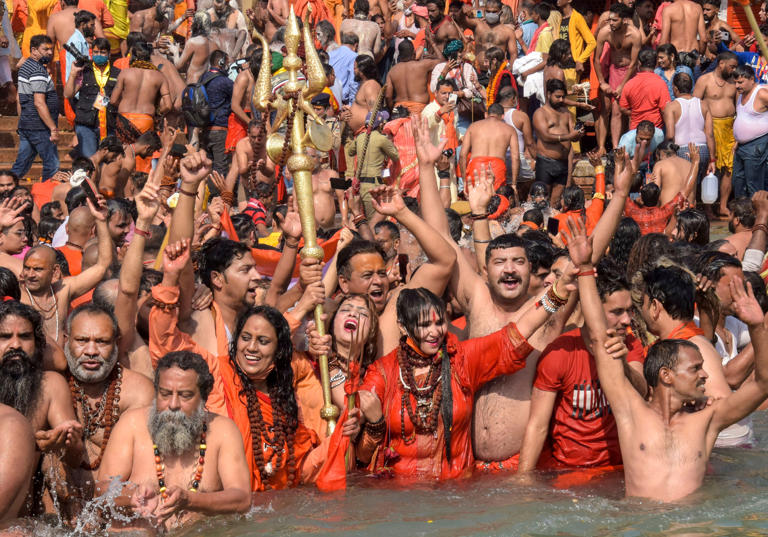Image Courtesy: PTI
The Maha Kumbh Mela, a grand confluence of spirituality, tradition, and faith, is set to take place in 2025 under a rare celestial alignment occurring once every 144 years. This unique event amplifies the spiritual potency of the rituals performed, particularly the holy dips at the Triveni Sangam—the confluence of the Ganges, Yamuna, and the mystical Saraswati rivers. Central to this monumental gathering are the Akhadas, traditional monastic institutions of ascetics and saints, each contributing uniquely to the spiritual tapestry of the festival.
What is an Akhada?
An Akhada (or Akhara) is a traditional Indian monastery that serves as a spiritual and sometimes martial institution for ascetics. The term “Akhada” originates from the Sanskrit word “Akhand,” meaning “indivisible.” Historically, Akhadas were established to protect and promote Sanatan Dharma during times of external threats.
Akhadas combine physical training with scriptural study and were deeply influenced by the teachings of Adi Shankaracharya in the 8th century. Today, Akhadas play a significant role in events like the Kumbh Mela, leading rituals such as the Shahi Snan (Royal Bath) and fostering a sense of community among devotees.
Types of Akhadas in Maha Kumbh 2025
The Akhadas participating in Maha Kumbh 2025 can be broadly categorized into Shaiva, Vaishnava, Udasin, and Kinnar Akhadas. Each group has its distinct philosophies, traditions, and roles within Hinduism.
1. Shaiva Akhadas
Dedicated to the worship of Lord Shiva, Shaiva Akhadas emphasize asceticism, meditation, and yogic practices. They are among the most prominent groups at the Kumbh Mela. Key Shaiva Akhadas include:
- Niranjani Akhada: Renowned for its scholarly contributions to spiritual discourse.
- Mahanirvani Akhada: Founded by Adi Shankaracharya, focusing on meditation and yoga.
- Avahan Akhada: Dedicated to Lord Shiva’s worship and integral to various rituals.
- Agni Akhada: Known for fiery rituals and strict ascetic practices.
- Anand Akhada: Promotes joy and spiritual happiness through its teachings.
- Atal Akhada: Highlights deep spiritual practices and community service.
A total of seven Shaiva Akhadas are expected to participate in Maha Kumbh 2025, playing pivotal roles in the festival’s rituals and traditions.
2. Vaishnava Akhadas
Vaishnava Akhadas worship Lord Vishnu and his avatars, focusing on devotion and philosophical teachings. Major Vaishnava Akhadas include:
- Sri Nirvani Akhada: Based in Ayodhya, dedicated to temple worship and Vishnu-centric rituals.
- Sri Digambar Akhada: Located in Varanasi, known for scriptural study and Vaishnavite philosophy.
- Nirmohi Ani Akhada: Emphasizes devotion to Lord Rama and community service.
Three Vaishnava Akhadas will actively participate in the Kumbh Mela, enriching the festival with their unique rituals and philosophies.
3. Udasin Akhadas
Udasin Akhadas blend Hindu ascetic traditions with Sikh influences. These Akhadas are inclusive and emphasize meditation and community upliftment. The Udasin Akhadas include:
- Naya Akhada: Known for its liberal spiritual outlook.
- Bara Akhada: Promotes traditional meditation and spiritual growth.
- Nirmal Panchayati Akhada: Recognized for its dedication to social service and education.
The three Udasin Akhadas highlight the diversity of spiritual practices at the Kumbh Mela.
4. Kinnar Akhada
The Kinnar Akhada, representing the transgender community, is a relatively new addition to the Kumbh Mela. Formed in 2015 under the leadership of Mahamandaleshwar Dr. Laxmi Narayan Tripathi, this Akhada has become a symbol of inclusivity and recognition for the Kinnar community within Hinduism.
The Kinnar Akhada’s participation adds a unique dimension to the festival, showcasing the evolving nature of spiritual traditions and their ability to embrace diversity.
The Role of Akhadas in Kumbh Mela
Akhadas are central to the Kumbh Mela’s rituals and ceremonies. Their processions during the Shahi Snan, featuring decorated elephants, horses, and vibrant bands, are a major highlight of the festival. Each Akhada is allotted specific time slots for their rituals, creating a mesmerizing display of devotion and tradition.
Modern Contributions of Akhadas
While many Akhadas continue to focus on spiritual and martial practices, others have embraced modern roles in education, social service, and community development. These evolving responsibilities reflect their adaptability and relevance in contemporary society.
Conclusion
The Maha Kumbh Mela 2025 promises to be a spiritual spectacle, with the diverse Akhadas playing vital roles in its grandeur. From the Shaiva Akhadas’ ascetic practices to the Kinnar Akhada’s message of inclusivity, each group contributes uniquely to the event. As millions gather to witness this celestial confluence, the Akhadas’ traditions, teachings, and rituals will continue to inspire and unite devotees from around the world.














